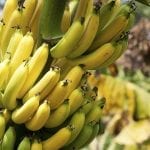This week’s posts are brought to you by the letter C, apparently.

So I was eating a banana today and I realized while I knew that most bananas exported around the world are Cavendish Bananas, named after the Cavendishes (“The Cavendishes”, it’s a great name and I will use it often), that was the extent of my immediate information on the subject. What followed was a research trail that lead to some fun places.
So the bananas were named after William Cavendish, the 6th Duke of Devonshire, son of 2/3rds of one of the most famous ménages à trois in history. (Yes, I did have to look up how to make ménage à trois plural, mon français est poubelle.) It’s my belief that the generally accepted story of The Cavendishes the Duke and Duchesses of Devonshire (Georgiana and Bess) is badly interpreted, and we’ll have to do a week presented by the letter D for that one. Enough of that digression. Back to bananas.
So the 6th Duke of Devonshire was super into gardening and shit, having the space for it in his big ol’ mansion they call a house. He happened upon Joeseph Paxton (of Crystal Palace fame), at the time just 20 years old working in the Horticultural Society’s Chiswick Gardens. Cavendish offered him the position of head gardener at Chatsworth and much gardening occurred.
Paxon was on the look-out for banana plants, supposedly because he really liked a plant depicted in some wallpaper in Chatsworth. He acquired some from Mauritius in 1834 and had them planted in the Chatsworth gardens. When they flowered and produced fruit in 1835 they were named after his rich boss and began to be distributed around the world.
Just a few years later, two Cavendish banana plants were given to famous Christian missionary colonizer John Williams to take with him to Samoa. Only one survived the journey, but it managed to spread Cavendish bananas and a whole banana industry all through the south sea.
After bringing bananas and religious nonsense to lots of people who didn’t ask, John Williams was murdered and eaten when he and his pal landed on the island of Erromango in the South Pacific. Some sandalwood traders from Australia had just days earlier murdered some folk, and thus the Erromango people were a bit on-edge. Thus, stabby stabby, chompy chompy.
Unfortunately, that wasn’t enough to keep the white people from invading their turf and more missionaries colonizers and sandalwood traders thieves followed. In 1857, a Mr. and Mrs. George N. Gordon showed up to do some Christian evangelizing. But in 1861 the natives were infected with measles by more white sandalwood traders (different sources give different scenarios of intention, but it’s not like this tactic hasn’t been used before and since by white people to genocide people they don’t like) and while the Gordons were helping with the sick, the death of the Erromangoan chief’s children was blamed on the Gordons and they were murdered.
This prompted George’s younger brother, James Gordon, to follow him only a few years later and continue pushing their Christian agenda. James then resorted to spreading the idea that the measles were a plague sent by God in punishment for murdering (and sometimes eating) the previous missionaries. He was murdered by natives in 1872.
Sadly the plague idea took hold, with some of the Erromango people believing that the island was cursed by God. The area is now mostly Christian. So Christian that in 2009, there was a reconciliation ceremony on the island for the family of of John Williams in the hopes of lifting the curse.
“Since we claim to be a Christian country it is very important that we have a reconciliation like this. Erromango needs it very much. People always look upon them that they killed a missionary, they think that it has sort of a curse on Erromango and that’s why it’s very important for them to have this reconciliation.”
― Iolo Johnson Abbil, President of Vanuatu
The ceremony included a reenactment of the murders (though perhaps not the cannibalism part), the renaming of the bay in which Mr. Williams was murdered was renamed to “Williams Bay”, and a seven year old child was “given” to the Williamses in exchange for the loss of life of their great-great grandfather which apparently means they’re responsible for her education. Which seems like a really weird apology and that the Erromangoans are maybe getting the better end of the deal here?
(I couldn’t not find the video by the BBC, only some low-res screenshots, sorry!)
I hope you enjoyed following me down this weird research hole. If you need some banana closure, the Cavendish is currently in trouble. I don’t even like bananas that much. But probably better to eat than Christian missionaries. Those probably taste awful.








